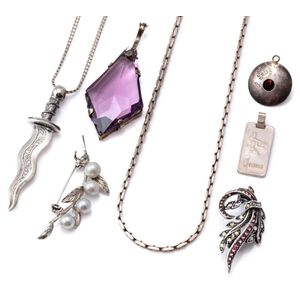Silver Jewelry Collection with Dagger and Pearls
Silver pendants chains and brooches, a 60 cm long scroll chain attached with a 60 mm keris dagger, a 62 cm long boston link chain, a nickel silver brooch set with 4 silver grey cultured pearls, length 50 mm, spray brooch set with rhinestones, length 40 mm, a 5g zodiac ingot, a Mexican silver sombrero charm and a lozenge cut purple paste set pendant, length 60 mm, total wt. 66.68g.
You must be a subscriber, and be logged in to view price and dealer details.
Subscribe Now to view actual auction price for this item
When you subscribe, you have the option of setting the currency in which to display prices to $Au, $US, $NZ or Stg.
This item has been sold, and the description, image and price are for reference purposes only.
- Nickel Silver - Nickel silver is a metal alloy made from copper, nickel, and zinc. Despite its name, it does not contain any silver. It was developed in the early 19th century in Germany as a less expensive alternative to silver, and it quickly gained popularity as a material for tableware, jewellery, and other decorative objects.
Nickel silver has a similar appearance to silver, with a bright, shiny surface that can be polished to a high lustre. It is also resistant to tarnish and corrosion, making it a durable material for long-lasting items. It is commonly used in the manufacturing of musical instruments such as flutes, saxophones, and clarinets, due to its acoustic properties. It is also used in the production of silverware, jewellery, and watch components, as an affordable alternative to precious metals like silver and gold. - Paste / Rhinestone / Diamante - Paste (or rhinestone or diamante) is the name given to a coloured glass composition used for imitation gemstones, or to imitation gemstones made of glass.
Although the technique of glassmaking had been known for thousands of years, but it wasn't until a lead glass with similar optical properties to diamonds were invented by a German jeweller working in Paris (either "Stras" or 'Strasser") in the early 18th century that "paste" gemstones became popular.
There was no social stigma attached to wearing imitation stones, and they were worn in situations where highway robbery was a possibility. The 18th century settings were of very high quality, equivilent to real gemstone jewellery.
In the nineteeth century the quality of paste jewellery declined and it has remained the poor cousin to genuine gemstones ever since.
This item has been included into following indexes:
